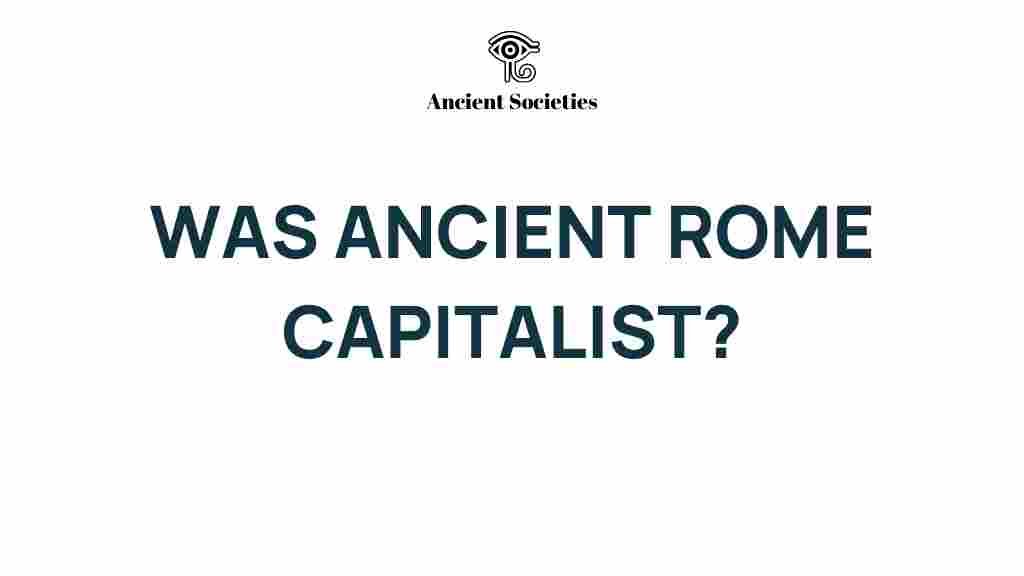Unraveling the Capitalist Threads of Ancient Rome
When discussing economic systems throughout history, few civilizations evoke as much intrigue as Ancient Rome. This sprawling empire, with its rich tapestry of trade, commerce, and innovation, laid the groundwork for modern economic paradigms. The threads of capitalism in Ancient Rome reveal a complex society that thrived on wealth accumulation, trade networks, and an innovative spirit that transformed the Mediterranean world. In this article, we will delve into the economic systems of Ancient Rome, exploring how they shaped their society and established a legacy that influences us even today.
The Economic Framework of Ancient Rome
To understand how capitalism manifested in Ancient Rome, we must first examine its economic framework. The Roman economy was multifaceted, relying on agriculture, trade, and a burgeoning market for goods and services. This economic system was characterized by several key components:
- Agriculture: The backbone of the Roman economy, agriculture provided sustenance and wealth for the populace. Large estates known as latifundia dominated the landscape, employing slave labor to maximize profits.
- Trade: Rome’s extensive trade networks facilitated the exchange of goods across the empire and beyond. Goods such as olive oil, wine, and grain were traded, establishing Rome as a central hub of commerce.
- Currency: The introduction of a standardized currency under the Roman Empire facilitated trade and economic transactions, making it easier for merchants and traders to conduct business.
- Innovation: The Romans were known for their engineering prowess, developing roads and maritime routes that enhanced trade and commerce.
Trade Networks and Their Impact on Society
Trade was not merely an economic activity in Ancient Rome; it was a defining feature of their society. The empire’s vast territory allowed for the exchange of goods, ideas, and cultures. Here are some significant aspects of trade in Ancient Rome:
- Maritime Trade: The Mediterranean Sea served as a bustling highway for Roman traders. Ports like Ostia and Alexandria became vital centers for the import and export of goods.
- Land Routes: The Roman road system, famous for its durability and engineering, connected various provinces, facilitating overland trade.
- Luxury Goods: Rome was a consumer of luxury items such as silk from China and spices from India, showcasing the empire’s wealth and the desire for exotic products.
These trade networks not only bolstered the economy but also influenced the social structure, creating a class of wealthy merchants and traders who played crucial roles in the political landscape.
The Role of Commerce in Wealth Accumulation
Commerce in Ancient Rome was a vehicle for wealth accumulation, leading to the emergence of a powerful merchant class. The following factors contributed to the growth of commerce:
- Marketplaces: Local markets were vital for the sale of goods, fostering a culture of commerce. The Forum served as the heart of Roman economic activity.
- Banking Systems: The Romans developed banking practices, including loans and credit, which facilitated business transactions and personal wealth accumulation.
- Investment Opportunities: Wealthy Romans often invested in trade expeditions, further fueling economic growth.
Innovation and Its Effects on the Economy
Innovation played a significant role in the economic systems of Ancient Rome. The Romans were adept at adopting and improving upon existing technologies, which enhanced their commercial capabilities:
- Engineering: Innovations in engineering, such as aqueducts and roads, allowed for efficient transportation of goods.
- Agricultural Techniques: The Romans implemented advanced farming techniques, improving crop yields and supporting a larger population.
- Legal Framework: The establishment of trade laws and regulations helped protect merchants and consumers, fostering a stable economic environment.
These innovations not only boosted the economy but also contributed to the overall prosperity of the Roman Empire.
Challenges to the Economic System
Despite its successes, the economic system of Ancient Rome faced numerous challenges that tested its resilience:
- Inflation: As the empire expanded, the devaluation of currency led to inflation, affecting trade and commerce.
- Political Instability: Civil wars and changes in leadership disrupted economic activities and trade routes.
- Dependency on Slavery: The reliance on slave labor created economic vulnerabilities, especially as the supply of slaves diminished over time.
The Legacy of Ancient Roman Capitalism
The economic systems of Ancient Rome have left a lasting legacy that continues to influence modern capitalism. Aspects of Roman commerce, trade practices, and innovations can be seen in today’s global economy:
- Global Trade Networks: The concept of interconnected trade routes established by the Romans is mirrored in today’s global supply chains.
- Banking and Finance: Modern banking practices have roots in Roman financial systems, including loans and credit.
- Marketplaces: The idea of marketplaces as centers of commerce is foundational to today’s economic activities.
Understanding these connections helps us appreciate the profound impact Ancient Rome had on shaping modern economic systems.
Conclusion: The Enduring Influence of Ancient Rome on Capitalism
In conclusion, Ancient Rome’s economic systems—rooted in trade, commerce, and innovation—laid the groundwork for capitalism as we know it today. The empire’s ability to create extensive trade networks, accumulate wealth, and innovate in commerce demonstrates a sophisticated understanding of economics that resonates through history. Despite the challenges faced, the legacy of Ancient Roman capitalism endures, influencing contemporary society and commerce.
As we study the threads of capitalism woven into the fabric of Ancient Rome, we gain insights into how historical economic systems can shape our modern world. If you’re interested in learning more about the economic systems of other ancient civilizations, you can explore this resource.
For a deeper dive into the innovations and societal impacts of Ancient Rome, check out this informative article.
This article is in the category History and created by AncientSocieties Team
